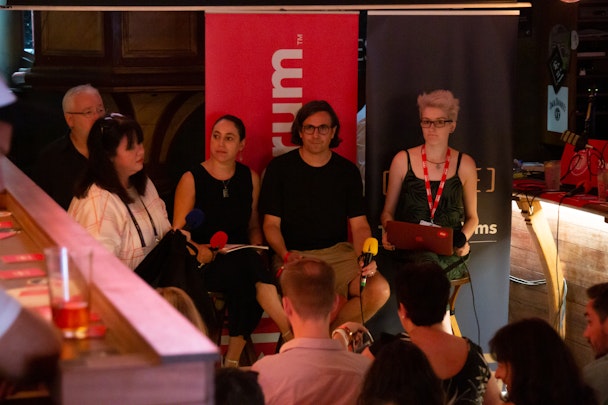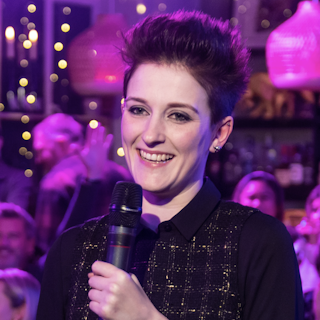A creative vision for your entertainment properties: How to ensure your brand messaging is entertaining
In a fragmented media landscape and with more creative produced in market every day, differentiation has become even more critical to brand marketers. Whether it be music, celebrity, or movie clip, entertainment content remains a vital ingredient to augment creative and capture consumer attention. The upside to tapping into the vein of pop-culture is immense, yet inserting entertainment into a brand’s messaging comes with risks, both legal and social.

The Drum in Cannes: GreenLight Panel
At a session in The Drum Arms held during the Cannes Lions Festival, in partnership with Greenlight, commercial writer, Danielle Gibson spoke to Michelle Spillane, chief marketing officer, Paddy Power; Xavier Rees, chief executive officer, Havas London and Sonia Bouadma, senior director, entertainment partnerships and licensing, Greenlight on how to avoid these pitfalls while explaining how best to harness entertainment to create stand-out advertising.
Using entertainment in advertising to engage with audiences
At Paddy Power, entertainment content is a big feature of the brand’s identity; it’s a part of its DNA, said Spillane. For the past 18 months, this has been a deliberate endeavour for the Irish bookmaker.
Let your audience guide you
“Prior to that, all too often we were chasing the funny, the gag. That's very difficult to do as a brand. Having worked in television and trying to create kind of comedy over and over is one of the most notoriously difficult things to do. Whereas entertaining people has a lot more breath, a lot more longevity. It's bigger, it's more inclusive and invites more people in.”
To find the answer to what their consumers wanted from Paddy Power, and to be the best version of themselves more often, focus groups were conducted and three lessons were learned time and time again; to be daring, be on the ball and to be one of the punters.
Being part of its consumer base is something Paddy Power reflects back to regularly. “That for us has created huge brand equity, which is the first brand I've ever worked for where our customers love to talk to us all of the time, want to genuinely hang out with us, and they love to talk about us,” added Spillane.
According to Bouadma at the digital agency Greenlight, which works with brands to increase sales and raise brand awareness with entertainment, there are are many different ways to engage. Take movies for example, he explained, if a brand wanted to raise its profile or maybe change the way consumers view it, the brand could associate with a movie which has a bit more of a cult following, and work with those properties to change people’s perceptions.
Rees adds that there's a time and a place for a badging exercise if it's relevant to do so, but the best use of entertainment properties is when brands and agencies do more than that. By using music, TV properties etc, this can help brands massively just setting a tone or mood helping explain the story they're trying to tell.
Working with brand ambassadors
Brands often rely on traditional ambassadors, celebrities, athletes, musicians and influencers with larger than life egos, but how do you know when or even if to stick with them when things go wrong?
Spillane says the worst thing in the world for Paddy Power is to have a vanilla ambassador. However, it’s not that that the betting operator want its brand ambassadors to go out and seek carnage in the media, Paddy Power wants them instead to have an opinion and own it, rather than falling in line with its management.
However, how brands use celebrities in advertising has not really changed over the years, said Rees. You still see an awful lot of blatant badging and there are perhaps better ways to do it. However, it is being done with more sophistication.
“Whether you like or hate him or the product, Diageo's partnership with David Beckham to create the Haig Club Whisky and then the products around it was very, very smart and really involving him in the entire concept, by getting Beckham’s input along the way and then involving him in the advertising as well,” he added.
But what if it all goes wrong? Rees adds that today we’re more accepting of human beings as being fallible. Once upon a time a brand when faced with a celebrity that they were partnering with screwing up in some way, the brand would have run a mile.
“A brand that sticks by a celebrity while they're getting through some shit could come out of it better than if they leave them. As long as whatever they've done doesn't drag the brand through the gutter in the meantime.”
Legal pitfalls
Of course, using music and celebrities in entertainment also comes with many legal pitfalls.
For the recent Tesco 100 year centennial campaign, Greenlight secured the rights for Mr.Blobby, Michael Van Wijck AKA “The Wolf” and the Lambrettas. Bouadma explained that if you want to work with a talent or a movie etc it all comes down to research, making sure that you're talking to the appropriate person who actually can grant you the rights.
“If you're working with a celebrity, they have a very strict process when it comes to putting together a firm offer which is binding. Just be sure that you want to engage with a celebrity before offering a certain amount of money to work with them because you might be stuck with these people.”
However, when you have a brand like Paddy Power, following traditional channels isn’t always on the top of the agenda. It is after all a guerrilla marketing brand. “Sometimes we ask ourselves the question, are we going to get sued?” said Spillanni. “If the answer to that is yes, then we're like, yeah, it's going to be amazing.”
Following Oprah’s 2017 Emmy speech which lead to many suggesting she should run for US President, the team at Paddy Power decided they wanted Oprah in a glass case outside the White House with a sign that said “break in case of emergency.” However, this didn’t go ahead, not because of the legal issues, but more for bigger commercial decisions. They saved it though and used it when Trump came to London in 2018.
Another pitfall would be the time between the decision to work with a celebrity or partnership and when it goes live, says Rees.
Having shot a campaign 18 months prior to it going live, Rees and his team had done all the checks of the people featuring in it before they went into production but because of the lead time between production and going live, they had to go back and do all of the checks again.
“And thank God we did because it meant we had to do some fairly serious editing because a lot can happen in 18 months,” he explained. “I would urge caution if there's going to be a long lead time between the production and going live in a kind of icon of detail in terms of looking at them again. You know, clearing them again before it goes live.”


